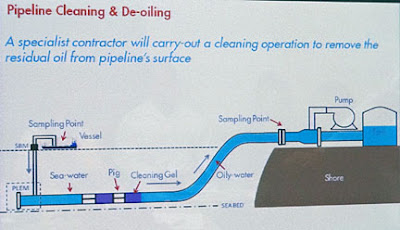Ramon Martinez, who is leading the project, gave a friendly and very detailed briefing of the project.
What is an SBM pipeline? It is a single buoy mooring (SBM) pipeline that transfers fluids between a tanker and another facility. They are capable of handling even very large crude carriers (VLCC) (from wikipedia). Here's a photo of a VLCC and a yellow SBM.
 |
| Photo from gcaptain |
 |
| Click on image for larger view. From the MPA navigation maps |
 |
| Click on image for larger view. |
 |
| Click on image for larger view. |
Terumbu Semakau has among the best seagrasses and good coral reefs of our submerged reefs. Here's a view of the reefy shore on one of our sunrise trips this year, facing the Semakau Landfill and Pulau Jong on the horizon.
And a view of the seagrass meadows on Terumbu Semakau. Here's more posts about trips to Terumbu Semakau and more photos of marine life at Terumbu Semakau.
The new pipes will be laid according to MPA guidelines which include an 'armour' of rocks to prevent accidental damage. To prepare the area, dredging will be done by the Queen of the Netherlands which is so famous it has its own wikipedia page. Shell says it is a "state of the art Trailer-Suction-Hopper dredger" and will do a good clean job of it. More about what a Trailing-Suction-Hopper dredge does. The dredging will take place from Sep to Dec 2012.
 |
| Photo from Dredging News Online |
Shell also shared how the pipes will be cleaned. Among others, this involves two 'PIG's (pipeline insertion gauges) in a process called 'pigging', more on wikipedia.
I'm glad to learn that the project team will work to share marine life specimens taken from the sea bed during their work with the Mega Marine Survey. They've already passed on some interesting specimens during their earlier survey. This fits in with the Mega Marine Survey's ongoing efforts to survey our sea bed which turns out to be surprisingly rich! Shell is one of the corporate sponsors of the Mega Marine Survey.
Also attending this briefing were Debby Ng of the Hantu Bloggers, and Jackie and Ricky from the Singapore Underwater Federation.
Ramon asked and we shared about recent dolphin sightings in the work area, like this sighting of a family of dolphins by Goh Pei Hao in 2011. More about dolphins in Singapore.
Ramon said a dugong was sighted by the project during preliminary work. Wow! He said they did report the sighting to SWiMMS. He asked about dugongs in the area and we shared about dugong feeding trails seen in May 2012 at Terumbu Pempang Laut quite close to Pulau Bukom. Kok Sheng also saw dugong feeding trails at Pulau Semakau in 2011. More about dugongs in Singapore.
 |
| Dugong feeding trails on Terumbu Pempang Laut near refineries on Pulau Bukom. Photo by Len McKenzie in the SeagrassWatch Magazine |
Debby and I also offered to give talks to Shell about the marine life found near Pulau Bukom and elsewhere. And to bring Shell on dives at Pulau Hantu or for an intertidal trip on the nearby shores.
| From the Hantu Blog |
We hope Shell will take up our invitation to help them discover the amazing marine biodiversity in Singapore, despite the many industrial uses and coastal developments that are taking place.
Update: Lau Jue Hua, the intern at Shell who sat in for the briefing has just signed up for the Mega Marine Survey and shared that he was keen to see our shores first hand. Bravo!






